As I did last year, I’m posting my favorite images of 2011, with a story and critique about each shot. Briefly summing up the year, I shot more kayaking and scenics, and less birds. I also did more targeting of specific images. By target I mean a particular type of image or location. For example, a drive to a clear lake for an underwater kayak Eskimo roll, or a specific location like Maligne Lake in Alberta for a (kayaking) mountain scenic. Sometimes targeting doesn’t work out if the light’s not there, like my Point-of-Arches sunset attempt (discussed below), but the strategy works to fill the portfolio for future sales. In 2011 I also shot many panoramas, setting up and shooting them in many locations. Finally, I drove my car a lot less. Shooting locally was key.
As I said last year, getting a favorite shot involves being where the action is when it happens, seeing—sometimes anticipating—the shot, using the right gear and technique, and often getting lucky with the light. To this I would add, research your target, determine the right day or season, then follow through and work it.

Bottle Beach Shorebird Assemblage: Bottle Beach on Gray’s Harbor is an easily-accessed Spring stop-over for migrating shorebirds: Dunlin, Western and Least Sandpiper, Black-bellied and Semipalmated Plover, Rudy Turnstone, Red Knot, Short-billed Dowitcher. The best shooting occurs as the birds move in with the tide, concentrating their numbers until eventually they pause for a time to rest between their ravenous feeding. I’ve visited Bottle Beach in late April or early May for over a dozen years. My photo strategy is get low. I usually wear a wetsuit, mount a 500mm f/4 on a 4” square block of wood and do a mud crawl to get within range. For this particular bird assemblage, the tide was still coming in strongly, and I wasn’t able to linger. After I got in position, water quickly rose to cover my elbows and lapped at my wood block, forcing a reverse mud crawl right after the shot. The final image was manually assembled in Photoshop from four images. I very much like the bird variety: five different species are easy to identify. This first image also portends a trend: seven of the twelve favorite images are composites.
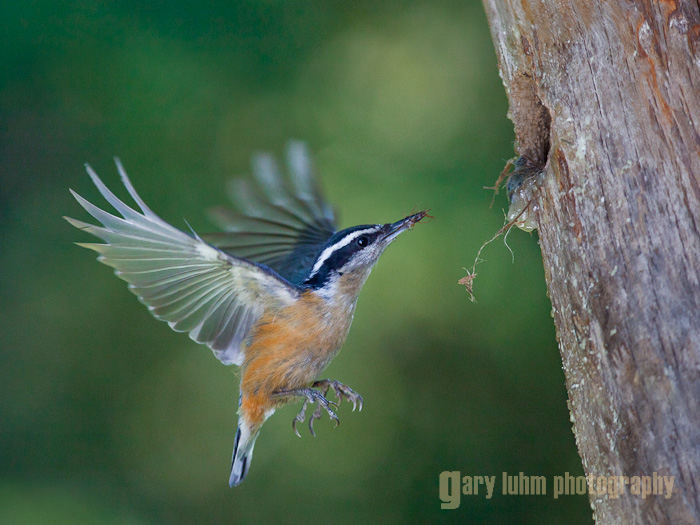
Backyard Nuthatch: In April, for the first time, I had Red-breasted Nuthatches take over a home-made nest hole on our back deck. They occupied it early, aggressively drove off other birds, brought in nest material of moss and dog hair and then globbed sticky pitch from a nearby Doug Fir around the entrance. Presumably the pitch deters intruders, and the Nuthatches avoid it by flying right into the hole. I loved these birds, in part because they were so tame, tolerating my presence on the deck even when I stood just a few feet from their home.
As the leaves filled out on the nearby Alder, I had the problem that the hole was always in shade beneath my overhung roof. Getting a fast shutter speed for flight shots would be difficult. I first tried several flash techniques, including high-speed sync and using multiple units, but I didn’t like the results. Much better, I found, was shooting on sunny afternoons. I used a couple of reflectors to bounce light toward the entrance, and thereby gained a couple of stops with a nice, even light. I shot at ISO’s of 1200 to 2000 to freeze flight action, but because the birds tolerated my presence, I could use my full-frame, low-noise Canon 5D II and a 200mm or 300mm lens. I got pleasing shots of the parent birds winging in with an entomologist’s joy of ants, spiders, beetles and grubs to feed their brood.
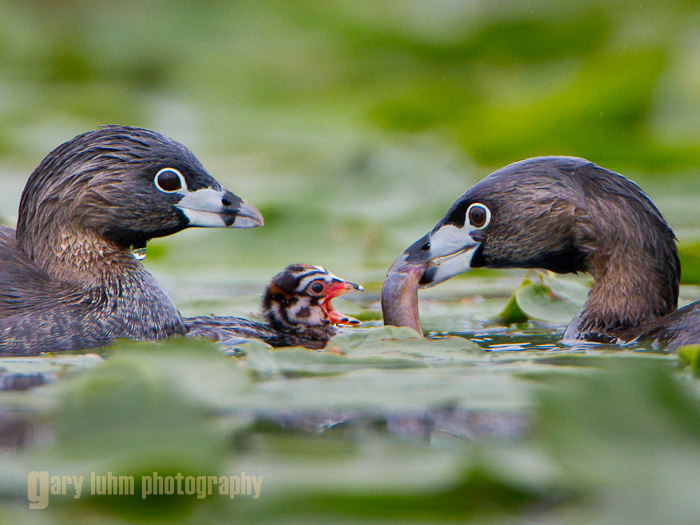
Biting Off More Than One Can Chew: If “Skinny as a Rail” has a bird origin, as it surely does, maybe “biting off more than one can chew” came from Pied-billed Grebes. I’ve witnessed this often over the years in Union Bay on Lake Washington, where numerous Grebe nests hatch youngsters to over-zealous parents. They’ll offer fish or amphibians longer in length than the chick, and proudly seem to expect the little guy to swallow it whole. This tiny guy was from a nearby floating nest in the lily pads, in an open area great for photography. The parents were moderately skittish, but nothing that a Canon 7D and 500mm lens couldn’t surmount if I kept still in the kayak.
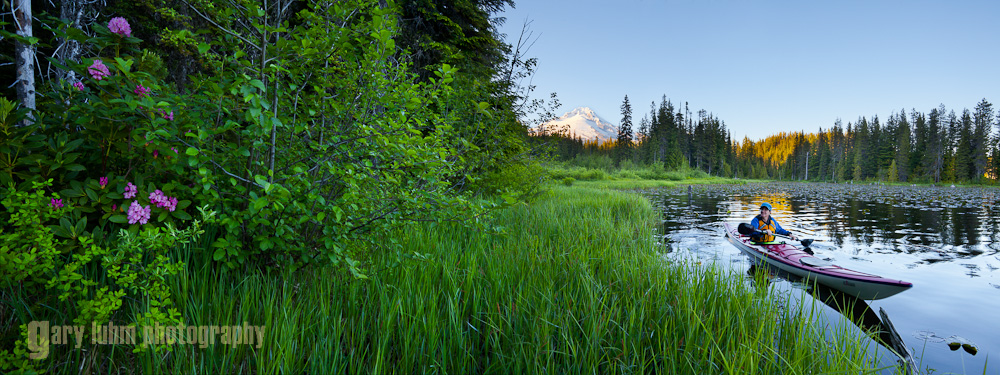
Ahh! Trillium Lake: My wife and I have taken various exploratory routes home after our annual family get-together in Central Oregon, and this year was no exception. In early July, on a zig-zaggy return trip, we discovered Trillium Lake, something of a Portland-area secret. Trillium has a large, lake-side campground, a spectacular view of Mt. Hood, and—when we visited in early July—a shoreline full of marsh, forest and sub-alpine flowers. For this image I set up the tripod. Since I couldn’t get the Rhododendron flowers, Mt. Hood and a kayaker in a single frame, I planned a three image photomerge in Photoshop: a left one of foliage and then two on the right to handle the large exposure difference between foreground and sky.
Trillium Lake offers so much to shoot—Bald Eagle and Osprey put on a great show, Belted Kingfisher dive from shoreline perches, Beavers slap the water, wildflowers line the shore and Rough-skinned Newt walk the bottom in the shallows. If you go early enough in the season, lovely Trillium flowers grace the forest floor beneath a Douglas Fir-dominated canopy around the lake. Omnipresent above it all is magnificent Mt. Hood. We’ll be back.
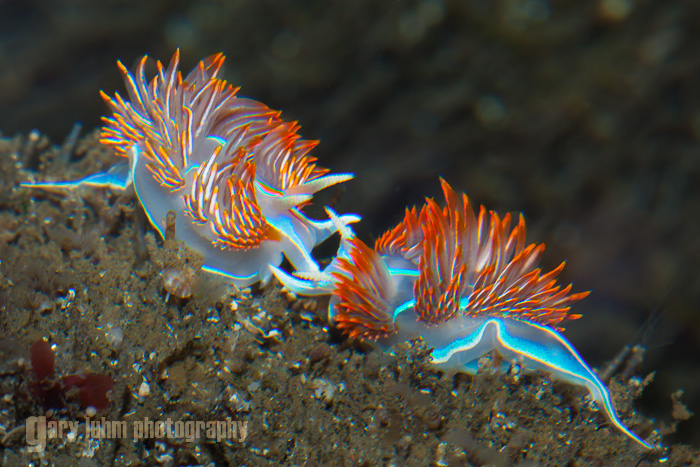
Opalescence: After a bust sunset and a bust sunrise, I was thinking this trip to Point-of-Arches on the Washington Coast might be a bust as well, but the morning minus tide beckoned, and I gathered up camera, tripod, flash and a couple lenses to saunter into some of the best tide-pooling in Washington State. I was targeting what is arguably the west coast’s most beautiful slug—Hermissenda Crassicornis—sometimes called the Opalescent Nudibranch. I also knew where to find it, and I found these sea slugs in abundance—so many that they were regularly interacting with each other. Though I don’t understand the behavior, having two of them cross lances for a few seconds made a great photo. All the light here is derived from flash. I shot hand-held for quickness, and at an angle to the water to prevent flash-reflected glare.
After the photo-bust sunrise start, this day was a day of superlatives. I scored three favorites of the year within a five-hour stretch. Wow.
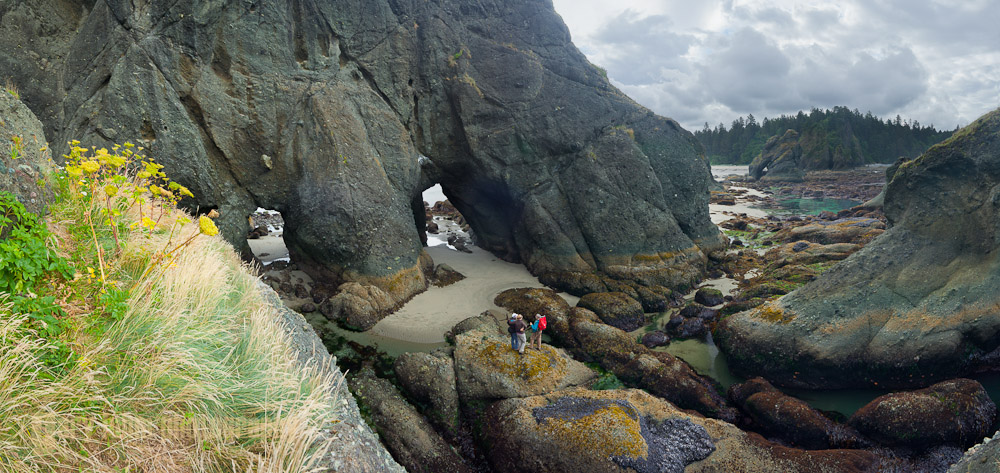
Point-of-Arches panorama, from a different perspective: My number one target on this trip was a sunset with folded-sandstone leading lines and Point-of-Arches sea stacks framing a colorful sky. Didn’t happen, but this P-of-A image, assembled in Photoshop from five (actually ten, counting the exposure bracketing) tripod-mounted verticals, was my trip favorite. I’ve also sold it already, and I’m sure the different perspective of an oft-shot scene played in the sale. I love the crossing diagonals, the repeat archways, the nooks for the eye to explore. It didn’t hurt that three women, one of them in red, moved into the central area as I was composing and paused there to chat. They add scale and interest, pushing the photo from a strong three-star to a five-star wonder.
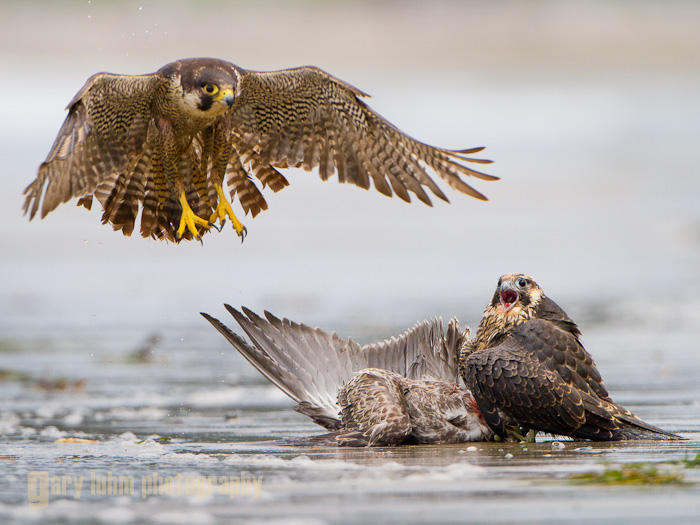
Peregrine Falcon Feed: One daily sight at Point-of-Arches was the pilgrimage of hikers slogging to the end of Shi-Shi beach. Most were campers that dropped their packs far down the beach, weary of the sand. They set up camp all along the two miles of beach; with binoculars, I counted 40 tents. The exciting daily sight, though, was the raptor show—especially the Peregrine Falcons. A couple of recently-fledged juveniles roosted in the trees near the Point, at times right above my tent. Unable to catch their own food, their job was to keep a keen eye on the parents. Occasionally they changed roosts, or would hop down on the sand and stalk sand flees for what seemed a not-so-serious play. The adult Peregrine’s job was to nail a Glaucous-winged Gull or two each day, mostly young birds, without getting the catch stolen by the local pair of Bald Eagles. The Peregrine adult usually delivered a surprise punch to a Gull in shallow water, dragged it ashore (the gull is too big to fly with), plucked feathers and partly consumed it, and then passed it to a juvenile. Sometimes it passed off a bird whole, as is happening here. The juvy took possession, tore into the gull, and cowled the catch if another bird came near. The Eagles job was to watch the Peregrines, and steal their catch, but if they grew impatient, they would fly to an off-shore sea stack where hundreds of gull nests had young, un-fledged birds for the taking. The Eagles had one fledged youngster. It hung out on one sea stack or another waiting for an adult bird to deliver the goods. The daily raptor show was awesome birding.
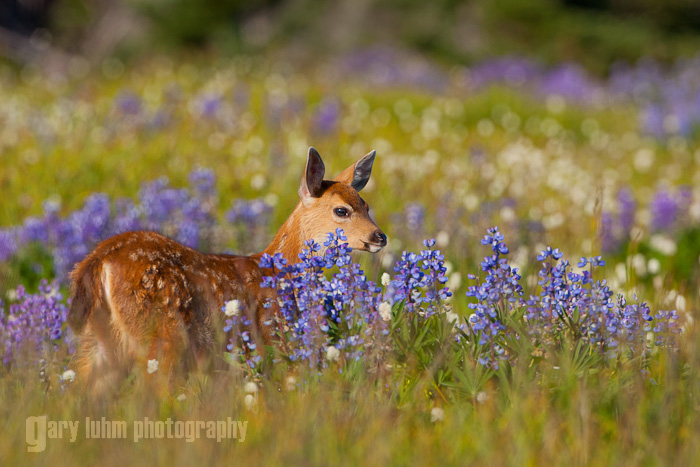
Fawn and Flowers: A deep snowpack and a cool spring doomed the sub-alpine wildflower show at Mt. Rainier and other North Cascade meadows, but at Hurricane Ridge and points east in the Olympics, it was only delayed. When it came, it was glorious. I thought the Hurricane Ridge lupine were the showiest I’d seen since probably 2000. But as is often the case here, a few fawns stole the show. I got this shot from the parking lot after following two fawns that popped up from a rest spot. I moved with them as best I could, trying to keep lupine patches in the fore, with a plain background, and the sun somewhat over the shoulder. The fawn’s head turned toward me, the immersion in flowers, the warm light and the out-of-focus areas created by the low-angle perspective make the shot.
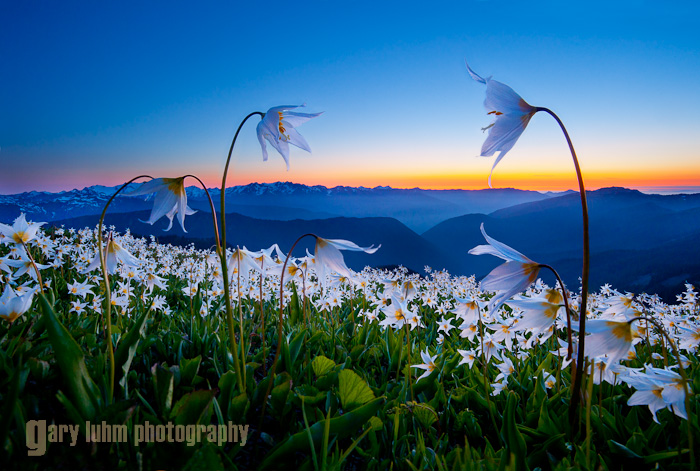
Avalanche Lily Sunset: Shortly after bagging the fawn shot, I motored out Obstruction Point Road to this enormous, already-scouted patch of Avalanche Lily. Along its edge I looked for and found a few flowers with a bit more height than the others. I wanted a low-angle shot, so I switched to Live View because there’s no way I could bend down to look through the viewfinder. I surveyed the “bug’s view” scene at arm’s length. When I found the “shot”, I mounted my camera on a Gorilla Pod and twisted and cranked the pod legs until Live View again revealed the pleasing composition. I made my exposures using a cable release (Canon TC80-N3) and auto-exposure bracketing. I also focus bracketed, focusing first on the foreground flowers, and then focusing on the background. Combining them in Photoshop took a lot of work because varying the focus moved the image elements slightly, and required some cloning to clean up. When done, I’d created a five-star image I really, really like. It draws me in to marvel at the splendor and beauty of life on earth.
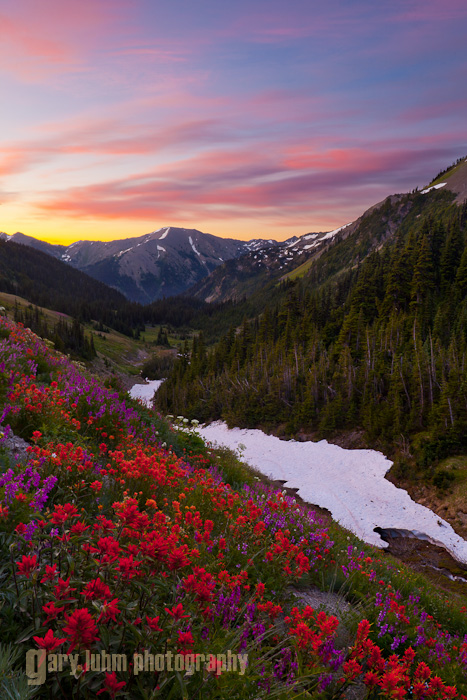
Badger Valley Sunrise: The following week, I’m back in Olympic National Park and the continuing wildflower show. Before dawn I park at the trailhead at the end of Obstruction Point Road. The sunrise has promising clouds, so a hike up high on Lillian Ridge could score a fabulous sunrise. I decide to descend into Badger Valley, though, where the sky will be less dramatic, but a fabulous foreground, scouted the day before, awaits. In twenty minutes I’m down at the shot site, and I quickly line up foreground elements of Paintbrush and Sweetbroom. I’m shooting with a 24mm TS-E (tilt-shift) lens, so I can tilt the lens to get everything in focus at a moderate f-stop. This also means I can shoot with a low ISO, though my shutter speed for two exposures ends up eight second for the foreground and two seconds for the sky. Thankfully, a breeze wasn’t blowing. Back home in Photoshop, I easily combine the two exposures for this striking image of Badger Valley in prime time.
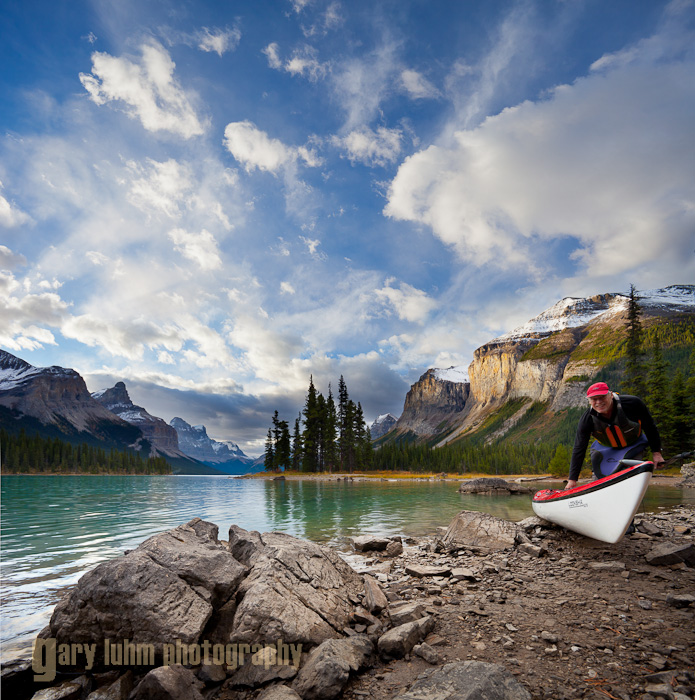
Spirit Island, Maligne Lake: In late September, I drove to Jasper National Park, Alberta, Canada, with the specific target of a kayaker at Spirit Island on Maligne Lake. Maligne is a fabulous lake, a 13-mile-long string bean with 10,000 ft peaks on both sides. I picked up a permit in the morning, and shortly after noon I paddled in to Fisherman’s camp for a two-night stay. Fisherman’s is eight miles in, and it gave me two sunset and two sunrise opportunities at nearby Spirit Island. The first sunset was a bust. The first sunrise looked so bad I paddled right on by and spent the morning exploring the lake’s south end. Then that evening, I beached until dusk at Spirit Island, waiting for some color. The sky looked pretty gray, and, with the peaks blocking the western sky, it limited my ability to judge the sunset. There simply wasn’t enough information. So I didn’t wait. I paddled back to camp. Eating dinner after sunset, the sky flicked red—gloriously red. I force a few images right from camp with uninteresting foregrounds and middle grounds, cursing the fact that I had left Spirit Island before the glow. I went to sleep knowing I’m 0-for-3.
That night the sky was mostly clear, raising my hopes, and before dawn I again paddled to Spirit Island. When I arrived a stiff breeze was blowing, and thickening clouds scudding by overhead spoiled the sunrise. I waited another an hour or so, hoping that at least the sun might pierce through and strike the west-side cliffs. While I was waiting I found the split rock that could add both a foreground element and something unique to the popular spot. I composed around the split rock and waited. Finally, the sun broke through on the cliffs, and I scrambled for a few launch and land photos. When I finished I looked up at a lovely sky, so I tilted the camera skyward and grabbed an “above” shot, mostly the sky above the cliffs, to add later in Photoshop. It would have been preferable to set up and shoot some verticals, but I didn’t think I had the time to reset the tripod and camera, and do another series of launch/land. The cloud cover was changing fast. As I paddled back to camp, the wind shifted to the south, and gray clouds rolled in. A misty rain enveloped the rest of my stay in Jasper.
A few days later I was home, and by combining my favorite horizontal with the “above” sky in Photoshop I got this squarish image of about 32 Megapixels. As I had hoped, it will be suitable for a double-truck or a magazine cover. I like it.

Tunnel Falls, Eagle Creek, Oregon: Toward the end of October I backpacked Eagle Creek in the Columbia River Gorge, with the primary goal of photographing Tunnel Falls. Eagle Creek is a popular and scenic trail, and deservedly so. The canyon is stunning, a jaw-dropping slot of green moss, conifer and black volcanic basalt. In the fall, scattered Big-leaf and Vine Maple add yellows and reds. Waterfalls Metlako and Punchbowl, both five-star drops, are on Eagle Creek only one and one-half and two miles in, an easy day hike for photographers. Tunnel Falls, though, is six miles in, twelve miles round trip, a bit much for short October days if you want to have any time for photography. So we backpacked.
We pitched our tent near Wy’East camp, about a mile short of Tunnel Falls. Then with camera gear and a few other essentials, we hiked in waning light to the falls. For the photograph, I set up the tripod and mounted my 5D II with a 70-200mm f/4L, and programmed my remote for a one-minute delay. Before starting the timer I did one crucial thing: donning a red jacket. There’s nothing like a red jacket for contrast with a green foliage background. I tripped the timer, walked to the falls, and got the shot—a vertical that included about a third or less of the falls. When I returned to the camera, I pointed it above and below and clicked until I had shot the whole falls with the same settings, a vertical panorama. After Photoshopping, the result was this tall, thin, 3744×18188 pixel image. I do regret that I didn’t shoot the whole thing with horizontals, but I moved quickly on to other captivating scenes. Oh well. I’ll just have to go back.
Gary